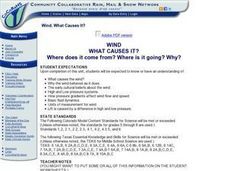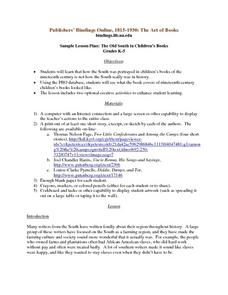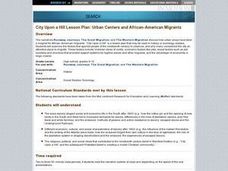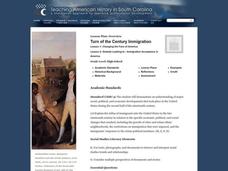Curated OER
America's Stone Age Explorers
Students watch a Nova program examining the earliest in habitants of the Americas. In groups. they take notes on various topics covered in the program. Among the topics covered are: the Clovis people, Solutrean culture, migration...
Curated OER
Wind, What Causes It?
Students explore what causes wind, why wind behaves as it does, early cultural beliefs about wind, high and low pressure systems, basic fluid dynamics, units of measurement for wind, and how lift is caused; students create and fly kites.
Curated OER
The Old South In Children's Books
Students discuss what is meant by the "Old South". In groups, they read stories about the Old South and discover this was not how the area actually was in that time period. They use a database to examine the covers of books and...
Curated OER
Investigating the Harlem Renaissance
The work of Langston Hughes opens the door to research into the origin and legacy of the Harlem Renaissance and how the literature of the period can be viewed as a commentary on race relations in America. In addition, groups are assigned...
Stanford University
Civil Rights or Human Rights?
Young citizens consider the American civil rights movement as part of the global struggle for human rights. After using a timeline activity to learn about the major events in the civil rights movement, class members study Malcolm X's...
Curated OER
The African Slave Trade: From West Africa to South Carolina and Beyond
Eighth graders explore the African slave trade. They identify the principal figures practicing the African slave trades at three locations. Students draw the physical routes of the slave trade on a map and they list the reasons for the...
Yale University
The Harlem Renaissance: Black American Traditions
Aaron Douglas, Meta Warrick Fuller, Palmer Hayden, William Johnson, and James Lesesne Wells, the painters and sculptors of the Harlem Renaissance, are featured in a unit study of artists of the Harlem Renaissance.
Curated OER
At the Crossroads
Third graders explore where South Africa is and then research details about the country to fully assess the background to the book, "At the Crossroads." They receive a map of Africa and color in the country of South Africa and list five...
CHPCS
The United States in the 1920s: The New Negro Movement and the Harlem Renaissance
Music, writing, and activism all tell the story of history! The resource uses these elements and more in a presentation to discuss the Jazz Age and Harlem Renaissance. Your class views biographies, discusses important events, and...
Curated OER
John Lennon’s Imagine and the Vietnam War in the 1970’s
Students analyze the song Imagine. In this Vietnam era lesson, students listen to and analyze the intention and meaning of Lennon's song "Imagine." They discuss what they think Lennon meant and how the song interplays with their own...
Curated OER
The Significance of the Buffalo
Students discuss the significance of the buffalo in their Native American community. They interview elders and take a field trip to a buffalo pasture. They conduct research in the library about how the buffalo was used in the...
Curated OER
Transportation and African-American Migration
Students explore the means of transportation available in the 19th century and its role as both facilitator and enabler of the westward expansion. They create a project board illustrating their findings.
Curated OER
City Upon a Hill: Urban Centers and African-American Migrants
Students examine why fugitive slaves migrated to cities and towns rather than rural areas. In this lesson, students consider the social, economic, and political benefits provided by cities and towns in comparison to rural areas.
Curated OER
At Your Fingertips
First graders observe a variety of different foods including kiwi, banbnas, coffee, chocolate and discuss where they come from. They discuss the terms import and export then identify the locations where the items came from and their...
Curated OER
Runaways Past and Present
Tenth graders use video and the Internet to compare runaway teenagers of the 1930s with runaways today. The lesson uses the integration of technology in order to build skills and conduct research.
Curated OER
Ancient Artifacts
Young scholars research the earliest Americans. In this ancient civilizations activity, students investigate the Mayas, Aztecs, and Incas. Young scholars examine artifacts used in the cultures and then determine what the artifacts were...
Curated OER
Catch the Gullah Beat: Rhythm and Percussion
Students explore the Gullah culture. In this social studies instructional activity, students construct and play instruments similar to those of the Gullah people.
Alabama Department of Archives and History
Alabama Slave Codes in 1833: What They Can Teach Us About Slaves Themselves
After viewing a short PowerPoint about Nat Turner's rebellion, class groups examine Alabama's 1833 slave codes. Individuals then develop a mini-legal brief arguing against one particular slave law.
Curated OER
Navajo Sand Paintings
Research the use of sand paintings in the Navajo tribe. Your students work together to design their own sand painting. They share their creation with the class describing what the symbols mean.
Curated OER
Lesson 9: After Slavery: Uncle Tom's Cabin in Popular Culture
Eighth graders, in groups, explore the popularity of Uncle Tom's Cabin, even in the post-slavery America.
Curated OER
Walking Down Main Street: The Changing Times of a Railroad Town
Students explore the historic district via a scavenger hunt. In this community history lesson, students complete a scavenger hunt using historic postcards and clues as guides. Students create a timeline demonstrating changes of the area...
Curated OER
Turn of the Century Immigration
Students explore the immigration wave that hit the United States in 19th century. In this immigration lesson, students examine primary and secondary sources to determine what the immigration experience was like for new citizens. Students...
Curated OER
Home Ties
Students explore the reasons people choose to migrate including political, economic and familial motivations. They interview family members and compare their ancestors own reasons for migration to those of African American urban migrants.
Curated OER
Coiling Geography "On the Pampas"
First graders are introduced to the rope coiling form of art used by the gaucho culture of South America. They read "On the Pampas" by Maria Cristina Brusca, view the illustrations of the coiling technique and create original pieces.

























